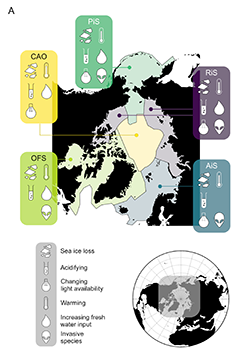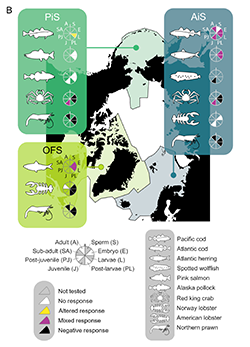Story
Using remote sensing technologies to understand the impact of ocean acidification on a remote Arctic
22 June 2021
In a new paper published in Frontiers in Marine Science, scientists call for increased consideration of ocean acidification to help inform future fish stock management in the Arctic Ocean, as well as publishing a roadmap for monitoring commercial fish stocks in this vulnerable and vital region.

The paper, led by scientists from Plymouth Marine Laboratory working with partners from the University of Exeter, Norwegian Institute of Water Research and the East China Normal University, outlines how ocean acidification must be considered with other potential stressors to accurately predict fish stocks in the Arctic, and therefore inform future fish stock management strategies.
The Arctic Ocean is particularly susceptible to ocean acidification and already experiences low pH levels not projected to occur on a global scale until 2100 so a better understanding of the impact of increasing acidity in this region is urgently required.
It is widely projected that under future climate scenarios the economic importance of Arctic Ocean fish stocks will increase. As waters warm, many marine species will move northwards to remain in their preferred temperature range. Atlantic cod and haddock, both of which have significant commercial value, have already expanded their range northwards, along with Pacific cod that has seen to have a summer northward range shift. However, in the process of moving northwards species will encounter additional environmental stressors with potential negative consequences for certain species and those that rely on them.
In addition, warming amplifies the Arctic’s susceptibility to ocean acidification with continued loss of multi-year ice, increasing the surface area of the ocean available for CO2 gas exchange and adding to the many pressures already facing the area.
Also highlighted in the study is the remote and often hostile nature of the Arctic Ocean. Collecting in situ data can be costly and challenging. This results in most datasets having a high seasonal bias toward the summer, in addition to little data being collected near multi-year sea ice. Sampling data is often fed into ecosystem models, which are used to project possible changes in stocks and ecosystem function so biased data can lead to inaccurate model outputs.
It has been found that laboratory studies also have their own limitations and there are some significant uncertainties regarding how to scale-up experiments from a single species to ecosystem level. To help address such issues as data bias and experiment limitations, the paper authors suggest gaps can be minimised using satellite observations as an additional tool.
 The roadmap in the paper, which recommends satellite observations are used to help address data gaps, sets out three interlinking research priorities:
The roadmap in the paper, which recommends satellite observations are used to help address data gaps, sets out three interlinking research priorities:
- Establish a comprehensive baseline of ecosystems and species by increasing coverage of the region in both space and time.
- Improve understanding of the variability of all stressors in space and time.
- Map fish stocks and the environmental conditions species are experiencing during different life-cycle stages against satellite-derived observations of stressors.
A stressor map has also been created, as a result of a literature review, to show the different stressors for each Arctic region alongside the impacted life stages of different species.
Hannah Green, PhD student at Plymouth Marine Laboratory and funded by an AXA XL Ocean Risk Scholarship, commented: “My PhD research is focused on using satellites as a method to observe ocean acidification in the Arctic and this paper is the first step in understanding our current knowledge regarding the extent to which ocean acidification is affecting Arctic fisheries and the importance of multi-stressor effects in this region. I hope the rest of my research will fill some of these knowledge gaps identified in the review.”
The paper concludes with proposed recommendations for moving these technologies forward alongside field, laboratory, and modelling research:
- Use Arctic specific satellite reprocessed datasets to develop Arctic-specific algorithms to monitor carbonate chemistry.
- Produce synoptic-scale datasets for carbonate chemistry, alongside temperature, ice cover, and ocean colour products from satellites, to provide a multi-stressor view.
- Improve biological observations of key fish species.
- Encourage research into all stages of the life cycle of key fish species.
- Continue to develop real-life variability and multi-stressors into experiments.
Related information
(A) Arctic regional map showing different stressors for each region. AiS, Atlantic influenced seas; PiS, Pacific influenced seas; RiS, river influenced seas; CAO, central Arctic Ocean; OFS, outflow shelves. (B) Species icons represent each commercial species where response OA has been studied. Black = negative response, white = no response, blank = not tested, yellow = significantly altered response, purple = mixed response (this includes both positive, negative and significant altered response). Each life stage tested is represented by the slice of the wheel next to icon of species.

